An Alternative Approach for Sustainable Management of Historic Urban Landscapes Through ANT via Algorithms: The Case of Bey’s Complex Palace in Constantine, Algeria
Abstract
1. Introduction
2. Literature Review
2.1. ANT’s Historical Background
2.2. ANT View of the Urban Landscape
2.3. The Spatial Agency Component
2.3.1. The Actor/Actant as an Agency
2.3.2. Actor Network as Agencies
2.4. Previous Studies: ANT Application in Historical Urban Landscapes
2.5. Mapping Controversies and Graph-Theoretic Algorithms as Practical Tools for the ANT Translation Process
3. Materials and Methods
3.1. Criteria for Selecting the Case Study
3.2. Data Collection Steps, Sampling and Sources
3.3. Procedural Workflow Process of the Proposed Method
4. Case Study Analysis
4.1. Architectural Features of Bey’s Palace Complex
4.2. Architectural Aesthetics and Functionality of Bey’s Palace
4.3. Courtyards Nodes of Social and Environmental Interaction
4.4. Materials and Traditional Crafts
4.5. Adaptive Reuse in Postcolonial Algeria
5. Results and Discussion
5.1. Results of the First Stage
5.2. Results of the Second Stage
5.3. Results of the Third Stage
5.3.1. First Step Results
5.3.2. The Second Step Results
5.4. The Integration and Discussion of These Results with Those of Previous Studies
5.5. Research Generalizability and Limitations
5.6. Research Study Implications
5.7. Recommendations for Future Research
6. Conclusions
Author Contributions
Funding
Institutional Review Board Statement
Data Availability Statement
Acknowledgments
Conflicts of Interest
References
- Ginzarly, M.; Houbart, C.; Teller, J. The Historic Urban Landscape approach to urban management: A systematic review. Int. J. Herit. Stud. 2019, 25, 999–1019. [Google Scholar] [CrossRef]
- Sharma, J.P. The monument and the city: Examining India’s legacy of monument-centric conservation in the context of the Historic Urban Landscape approach. In The Routledge Handbook on Historic Urban Landscapes in the Asia-Pacific; Routledge: Abingdon, UK, 2019; pp. 544–559. [Google Scholar] [CrossRef]
- Ventre, S.; Cerreta, M. Assemblages for Cultural Heritage: A Methodological Approach of Heritage-Driven Enhancement. In Proceedings of the International Conference on Computational Science and Its Applications (ICCSA 2024), Hanoi, Vietnam, 1–4 July 2024; pp. 356–372. [Google Scholar] [CrossRef]
- Taylor, K.; Lennon, J. Cultural landscapes: A bridge between culture and nature? Int. J. Herit. Stud. 2011, 17, 537–554. [Google Scholar] [CrossRef]
- Battis-Schinker, E.; Al-Alawi, S.; Knippschild, R.; Gmur, K.; Książek, S.; Kukuła, M.; Belof, M. Towards quality-of-life indicators for historic urban landscapes—Insight into a German-Polish research project. Environ. Sustain. Indic. 2021, 10, 100094. [Google Scholar] [CrossRef]
- Li, J.; Wang, J.; Li, X. Heritage Value Assessment and Landscape Preservation of Traditional Chinese Villages Based on the Daily Lives of Local Residents: A Study of Tangfang Village in China and the UNESCO HUL Approach. Land 2024, 13, 1535. [Google Scholar] [CrossRef]
- Callon, M. Some elements of a sociology of translation: Domestication of the scallops and the fishermen of St Brieuc Bay. In Power, Action and Belief: A New Sociology of Knowledge; Law, J., Ed.; Routledge & Kegan Paul: London, UK, 1984; pp. 196–233. [Google Scholar] [CrossRef]
- Latour, B. Reassembling the Social: An Introduction to Actor-Network-Theory; Oxford University Press: Oxford, UK, 2005. [Google Scholar]
- Law, J. Notes on the theory of the actor-network: Ordering, strategy, and heterogeneity. Syst. Pract. 1992, 5, 379–393. [Google Scholar] [CrossRef]
- Farías, I. Introduction: Decentring the object of urban studies. In Urban Assemblages; Routledge: London, UK, 2012; pp. 1–24. [Google Scholar] [CrossRef]
- Acuto, M. Putting ANTs into the mille-feuille. City 2011, 15, 552–562. [Google Scholar] [CrossRef]
- Yaneva, A. Mapping Controversies in Architecture; Routledge: London, UK, 2016. [Google Scholar] [CrossRef]
- Venturini, T. Diving in magma: How to explore controversies with actor-network theory. Public Underst. Sci. 2010, 19, 258–273. [Google Scholar] [CrossRef]
- Latour, B. Science in Action: How to Follow Scientists and Engineers Through Society; Harvard University Press: Cambridge, MA, USA, 1987. [Google Scholar]
- Boelens, L. Theorizing practice and practising theory: Outlines for an actor-relational-approach in planning. Plan. Theory 2010, 9, 28–62. [Google Scholar] [CrossRef]
- Karvonen, A. Relational politics and the urban landscape. In Proceedings of the Association of Collegiate Schools of Planning Annual Conference, Milwaukee, WI, USA, 17–21 October 2007. [Google Scholar]
- Latour, B. On Recalling ANT. Sociol. Rev. 1999, 47, 15–25. [Google Scholar] [CrossRef]
- Cvetinovic, M.; Nedovic-Budic, Z.; Bolay, J.C. Decoding urban development dynamics through actor-network methodological approach. Geoforum 2017, 82, 141–157. [Google Scholar] [CrossRef]
- Greenhough, B.J. Actor-Network Theory. In International Encyclopedia of Geography: People, the Earth, Environment and Technology; Wiley: Hoboken, NJ, USA, 2016; pp. 1–7. [Google Scholar] [CrossRef]
- Bowers, T. Heterotopia and actor-network theory: Visualizing the normalization of remediated landscapes. Space Cult. 2018, 21, 233–246. [Google Scholar] [CrossRef]
- Qviström, M. Searching for an open future: Planning history as a means of peri-urban landscape analysis. J. Environ. Plann. Manag. 2013, 56, 1549–1569. [Google Scholar] [CrossRef]
- Ruming, K. A new network direction in housing studies: The case of actor-network theory. In Proceedings of the 3rd Annual Australasian Housing Researchers’ Conference, AHRC08. Melbourne, Australia, 18–20 June 2008; pp. 1–18. [Google Scholar]
- Podolny, J.M.; Page, K.L. Network forms of organization. Annu. Rev. Sociol. 1998, 24, 57–76. [Google Scholar] [CrossRef]
- Allen, C.D. On actor-network theory and landscape. Area 2011, 43, 274–280. [Google Scholar] [CrossRef]
- Ernstson, H. Rhizomia: Actors, Networks and Resilience in Urban Landscapes. Ph.D. Thesis, Department of Systems Ecology, Stockholm University, Stockholm, Sweden, 2008. [Google Scholar]
- Wang, P.; Xie, S.; Xu, H. Re-conceptualizing the ideal homes in rural China: An actor-network theory approach. Humanit. Soc. Sci. Commun. 2023, 10, 513. [Google Scholar] [CrossRef]
- Ruming, K. Following the Actors: Mobilising an Actor-Network Theory Methodology in Geography. Aust. Geogr. 2009, 40, 451–469. [Google Scholar] [CrossRef]
- Ernstson, H.; Sörlin, S. Weaving protective stories: Connective practices to articulate holistic values in the Stockholm National Urban Park. Environ. Plann. A 2009, 41, 1460–1479. [Google Scholar] [CrossRef]
- Tietjen, A. Translations: Experiments in landscape design education. In Proceedings of the Nordes 2013: Experiments in Design Research, Copenhagen, Denmark; Malmö, Sweden, 9–12 June 2013. [Google Scholar] [CrossRef]
- Dobson, S. Urban translations: Regeneration through the lens of actor-networking. Local Econ. 2015, 30, 944–960. [Google Scholar] [CrossRef]
- Kim, J. Designing multiple urban space: An actor-network theory analysis on multiplicity and stability of public space. J. Urban Des. 2019, 24, 249–268. [Google Scholar] [CrossRef]
- Bernsteiner, J.; Ninan, J. Actor-networks in sustainable transport transformation: The case of the Catharijne-singel restoration. In Proceedings of the Institution of Civil Engineers-Municipal Engineer; Emerald Publishing Limited: Leeds, UK, 2024; pp. 1–13. [Google Scholar] [CrossRef]
- Gutiérrez, J.L.M. On actor-network theory and algorithms: ChatGPT and the new power relationships in the age of AI. AI Ethics 2023, 1, 1071–1084. [Google Scholar] [CrossRef]
- Yaneva, A.; Heaphy, L. Urban Controversies and the Making of the Social. ARQ Archit. Res. Q. 2012, 16, 29–36. [Google Scholar] [CrossRef]
- Palmer, J.S. Network mapping of housing systems: The case of medium-density dwelling design in Australia. In Proceedings of the RSD3, Third Symposium of Relating Systems Thinking to Design, Oslo, Norway, 15–17 October 2014; Available online: http://openresearch.ocadu.ca/id/eprint/2103/ (accessed on 29 October 2025).
- Arul, S.M.; Senthil, G.; Jayasudha, S.; Alkhayyat, A.; Azam, K.; Elangovan, R. Graph Theory and Algorithms for Network Analysis. In E3S Web of Conferences; EDP Sciences: Les Ulis, France, 2023; Volume 399, p. 08002. [Google Scholar] [CrossRef]
- Tselykh, A.; Denisov, B. Graph-Theoretic Models for the Holistic Analysis of Actor-Networks with Emergent Properties. IOP Conf. Ser. Mater. Sci. Eng. 2020, 790, 012048. [Google Scholar] [CrossRef]
- Solli, A.; Mäkitalo, Å.; Hillman, T. Rendering controversial socioscientific issues legible through digital mapping tools. Int. J. Comput. Support. Collab. Learn. 2018, 13, 391–418. [Google Scholar] [CrossRef]
- Hashimoto, T.B.; Nagasaki, M.; Kojima, K.; Miyano, S. BFL: A node and edge betweenness based fast layout algorithm for large scale networks. BMC Bioinform. 2009, 10, 19. [Google Scholar] [CrossRef]
- Kim, I.S.; Kunisky, D. Mapping political communities: A statistical analysis of lobbying networks in legislative politics. Polit. Anal. 2021, 29, 317–336. [Google Scholar] [CrossRef]
- Venturini, T.; Munk, A.K. Controversy Mapping: A field Guide; John Wiley & Sons: Hoboken, NJ, USA, 2021. [Google Scholar]
- Ji, J.; Heath, T. The Spatial Transformation of the Villages around Chang’an Cultural Heritage Site Based on Actor Network Theory. Sustainability 2023, 15, 10846. [Google Scholar] [CrossRef]
- Aka, K.G. Actor-Network Theory-based Applications in Sustainability: A systematic literature review. Cleaner Prod. Lett. 2024, 8, 100084. [Google Scholar] [CrossRef]
- Wei, W. Using actor–network theory to revisit the digitalized tool in social design. Des. J. 2024, 27, 49–67. [Google Scholar] [CrossRef]
- van Eck, N.; Waltman, L. Software survey: VOSviewer, a computer program for bibliometric mapping. Scientometrics 2010, 84, 523–538. [Google Scholar] [CrossRef] [PubMed]
- van Eck, N.J.; Waltman, L. Text mining and visualization using VOSviewer. arXiv 2011, arXiv:1109.2058. [Google Scholar] [CrossRef]
- van Eck, N.J.; Waltman, L. How to normalize cooccurrence data? An analysis of some well-known similarity measures. J. Am. Soc. Inf. Sci. Technol. 2009, 60, 1635–1651. [Google Scholar] [CrossRef]
- Hlosta, M.; Šebek, M.; Zendulka, J. Approach to visualisation of evolving association rule models. In Proceedings of the Second International Conference on Informatics & Applications (ICIA), Lodz, Poland, 23–25 September 2013; IEEE: New York, NY, USA, 2013; pp. 47–52. [Google Scholar] [CrossRef]
- Waltman, L.; van Eck, N.J. A smart local moving algorithm for large-scale modularity-based community detection. Eur. Phys. J. B 2013, 86, 471. [Google Scholar] [CrossRef]
- Latour, B. Social theory and the study of computerized work sites. In Information Technology and Changes in Organizational Work; Springer: Boston, MA, USA, 1996; pp. 295–307. [Google Scholar] [CrossRef]
- Star, S.L.; Griesemer, J.R. Institutional ecology, translations and boundary objects: Amateurs and professionals in Berkeley’s Museum of Vertebrate Zoology, 1907–1939. Soc. Stud. Sci. 1989, 19, 387–401. [Google Scholar] [CrossRef]
- Perianes-Rodriguez, A.; Waltman, L.; Van Eck, N.J. Constructing bibliometric networks: A comparison between full and fractional counting. J. Informetr. 2016, 10, 1178–1195. [Google Scholar] [CrossRef]
- van Eck, N.J.; Waltman, L. VOSviewer Manual; Leiden University: Leiden, The Netherlands, 2023; Available online: https://www.vosviewer.com/documentation/Manual_VOSviewer_1.6.20.pdf (accessed on 29 October 2025).
- Bihari, A.; Pandia, M.K. Eigenvector centrality and its application in research professionals’ relationship network. In Proceedings of the International Conference on Futuristic Trends on Computational Analysis and Knowledge Management (ABLAZE), Noida, India, 25–27 February 2015; IEEE: New York, NY, USA, 2015; pp. 510–514. [Google Scholar] [CrossRef]
- Mauri, M.; Elli, T.; Caviglia, G.; Uboldi, G.; Azzi, M. RAWGraphs: A visualisation platform to create open outputs. In Proceedings of the 12th Biannual Conference on Italian SIGCHI, Cagliari, Italy, 18–20 September 2017. Article 1. [Google Scholar] [CrossRef]
- Erkan, G.; Radev, D.R. LexRank: Graph-based lexical centrality as salience in text summarization. J. Artif. Intell. Res. 2004, 22, 457–479. [Google Scholar] [CrossRef]
- Noack, A. Modularity clustering is force-directed layout. Phys. Rev. E 2009, 79, 026102. [Google Scholar] [CrossRef]
- Blondel, V.D.; Guillaume, J.-L.; Lambiotte, R.; Lefebvre, E. Fast unfolding of communities in large networks. J. Stat. Mech. Theory Exp. 2008, 2008, P10008. [Google Scholar] [CrossRef]
- Bukar, U.A.; Sayeed, M.S.; Razak, S.F.A.; Yogarayan, S.; Amodu, O.A.; Mahmood, R.A.R. A method for analyzing text using VOSviewer. MethodsX 2023, 11, 102339. [Google Scholar] [CrossRef]
- Ahmed, I.; Aziz, A. Dynamic approach for data scrubbing process. Int. J. Comput. Sci. Eng. 2010, 2, 416–423. [Google Scholar]
- Welbers, K.; Van Atteveldt, W.; Benoit, K. Text analysis in R. Commun. Methods Meas. 2017, 11, 245–265. [Google Scholar] [CrossRef]
- VOSviewer. Available online: http://www.vosviewer.com (accessed on 29 October 2025).
- van Eck, N.J.; Waltman, L. Visualizing bibliometric networks. In Measuring Scholarly Impact: Methods and Practice; Springer: Cham, Switzerland, 2014; pp. 285–320. [Google Scholar] [CrossRef]
- Venturini, T. Building on faults: How to represent controversies with digital methods. Public Underst. Sci. 2012, 21, 796–812. [Google Scholar] [CrossRef] [PubMed]
- Prado, A.B.; Baranauskas, M.C.C. Addressing structural and dynamic features of scientific social networks through the lens of Actor-Network Theory. Soc. Netw. Anal. Min. 2013, 3, 1263–1276. [Google Scholar] [CrossRef]
- Hodgkinson, G.P.; Starbuck, W.H. (Eds.) The Oxford Handbook of Organizational Decision Making; Oxford University Press: Oxford, UK, 2008. [Google Scholar] [CrossRef]
- Liu, F.; Maitlis, S. Emotional dynamics and strategizing processes: A study of strategic conversations in top team meetings. J. Manag. Stud. 2014, 51, 202–234. [Google Scholar] [CrossRef]
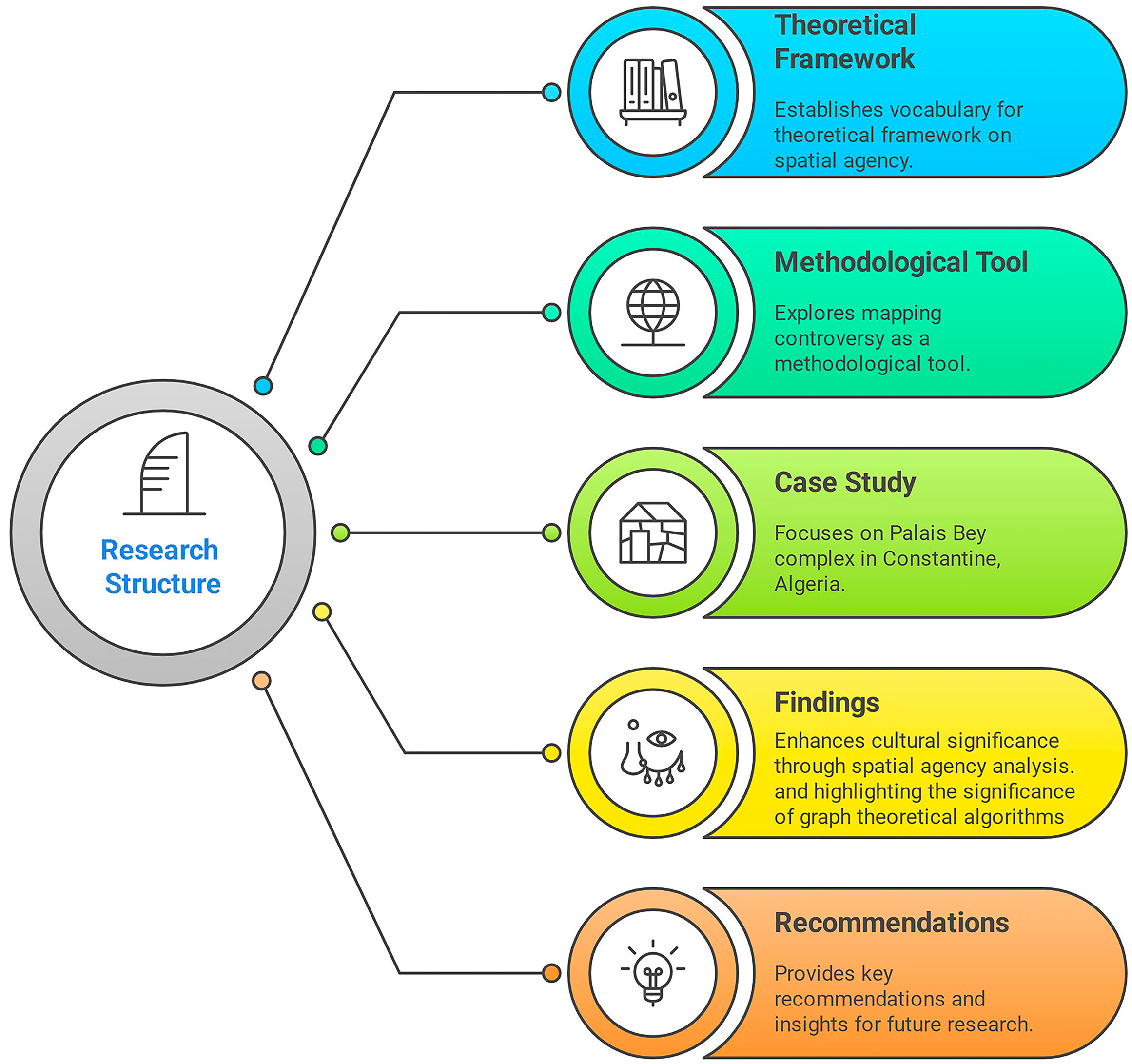

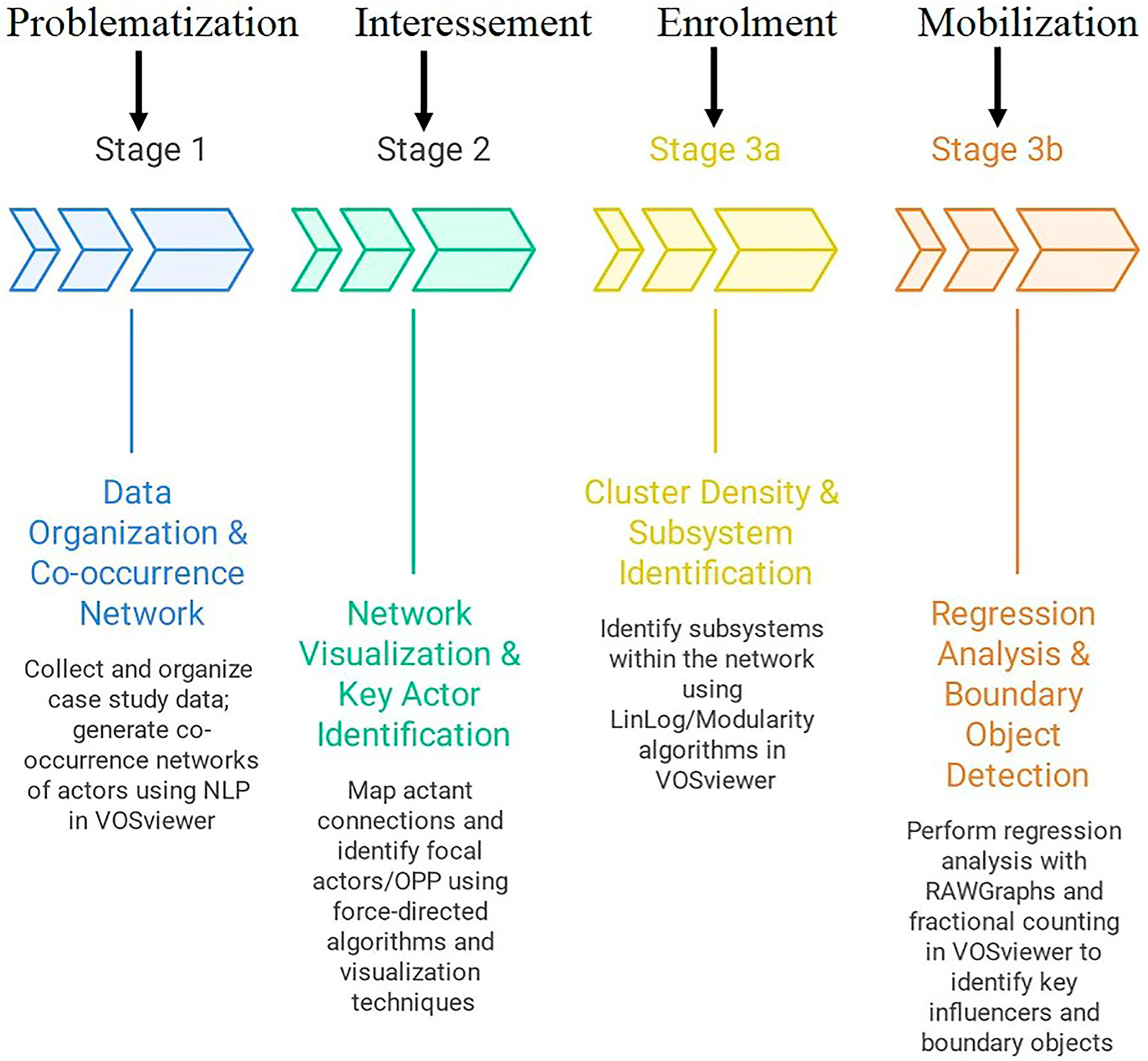


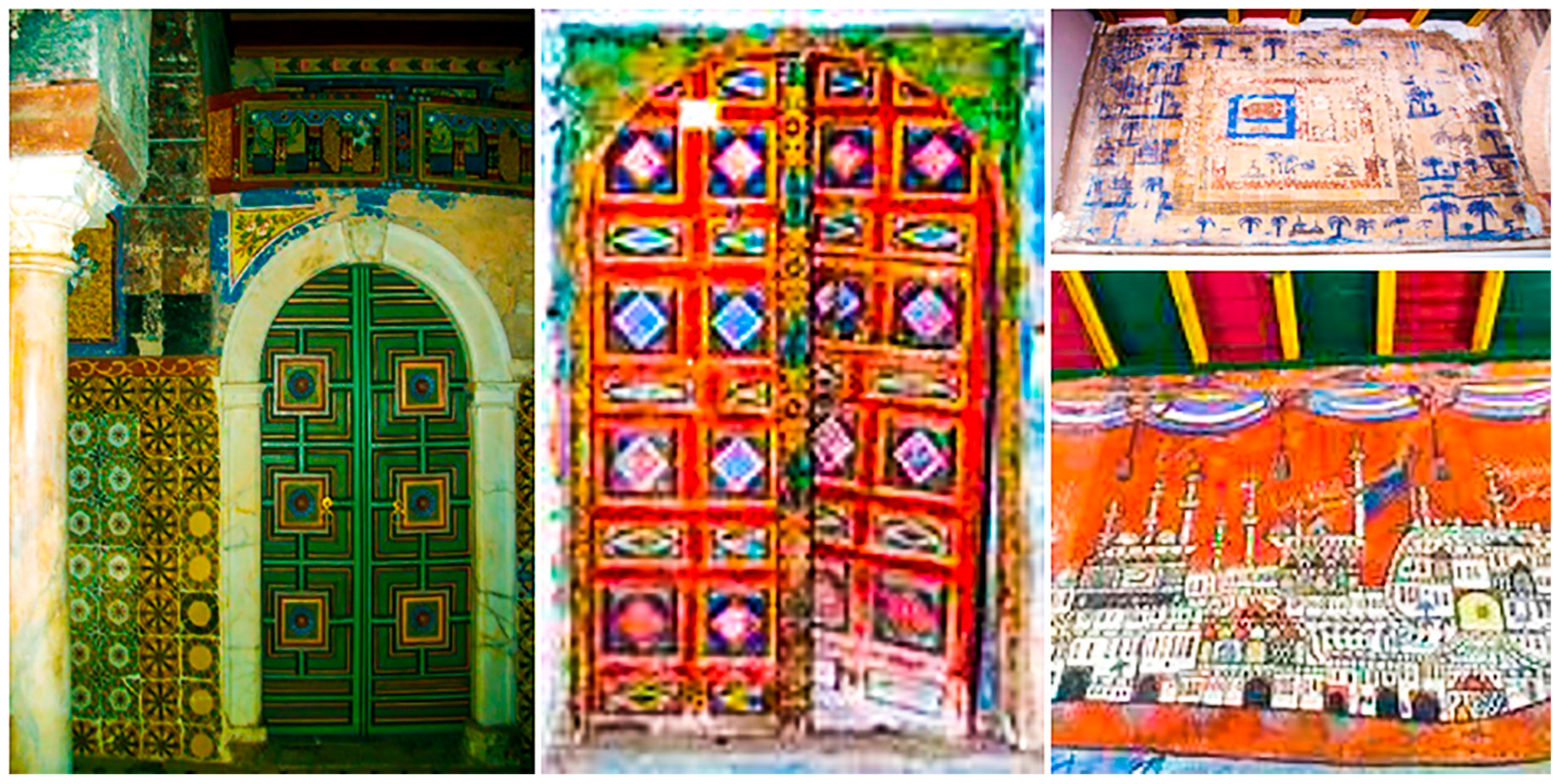
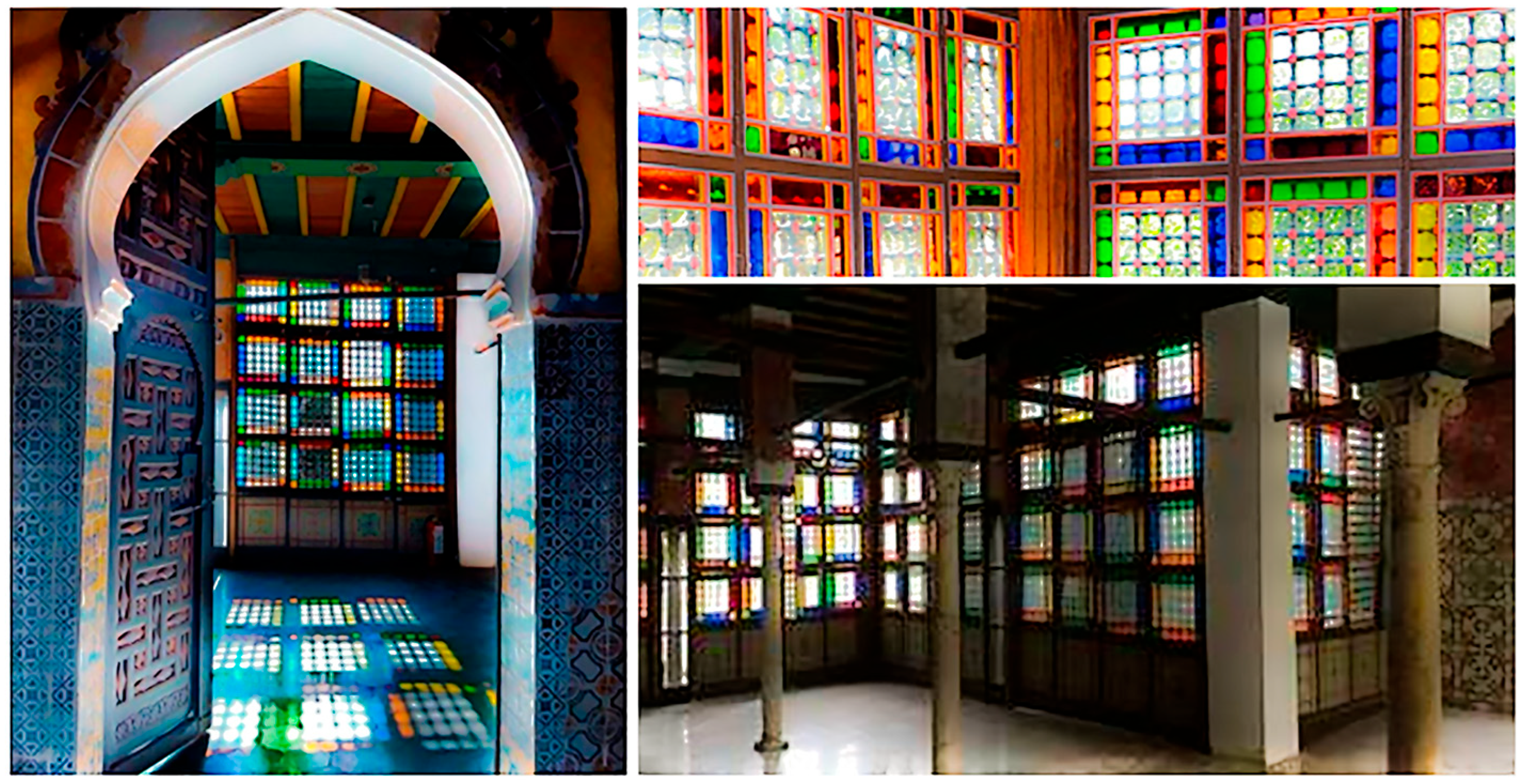
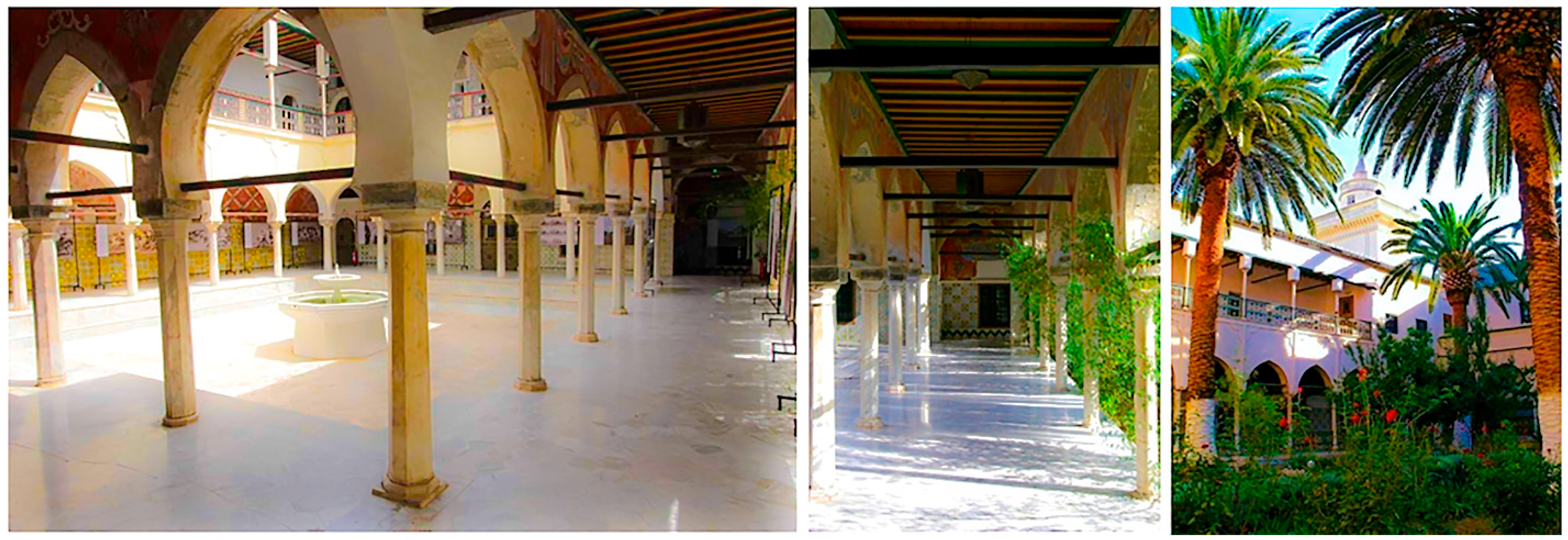
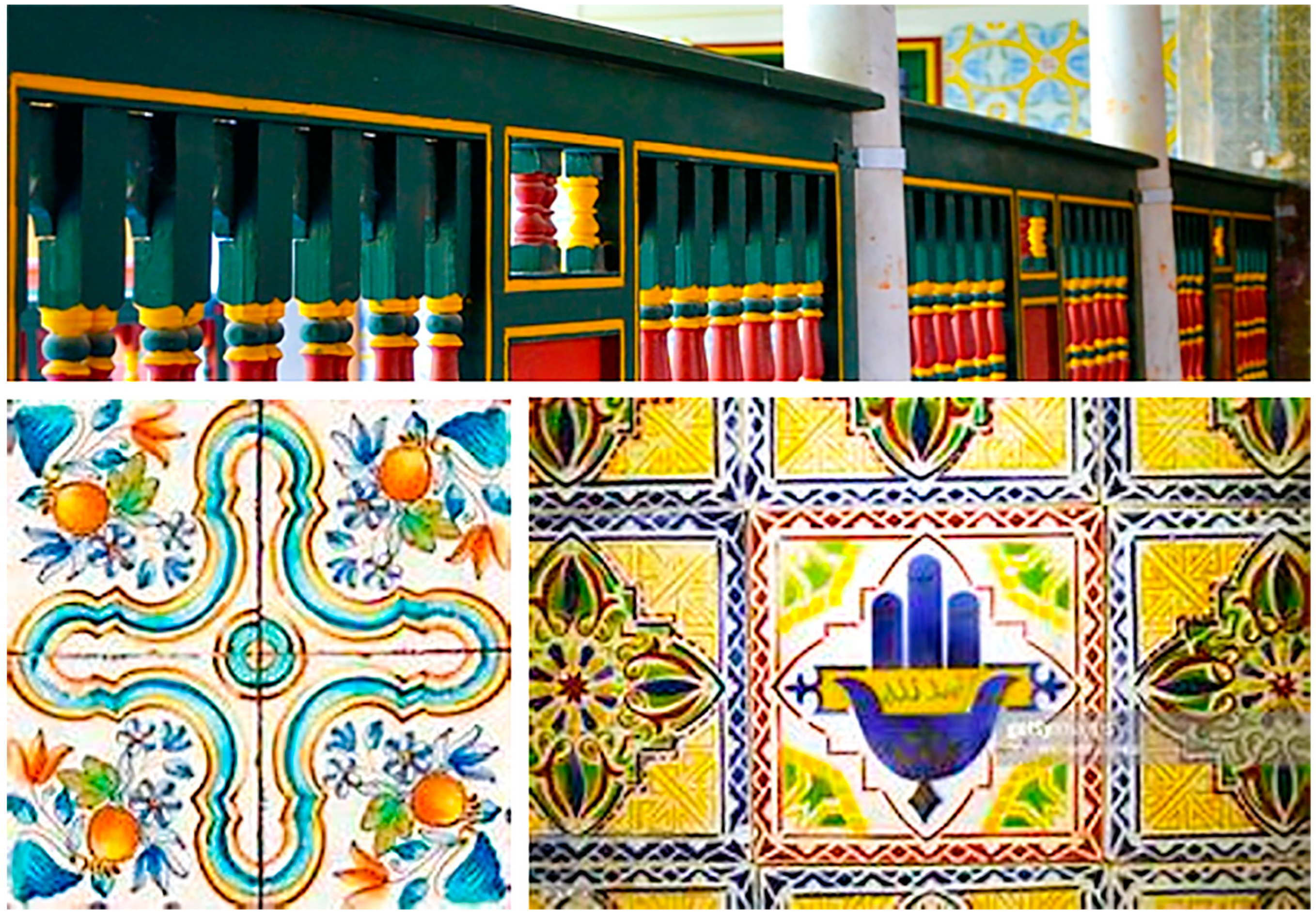


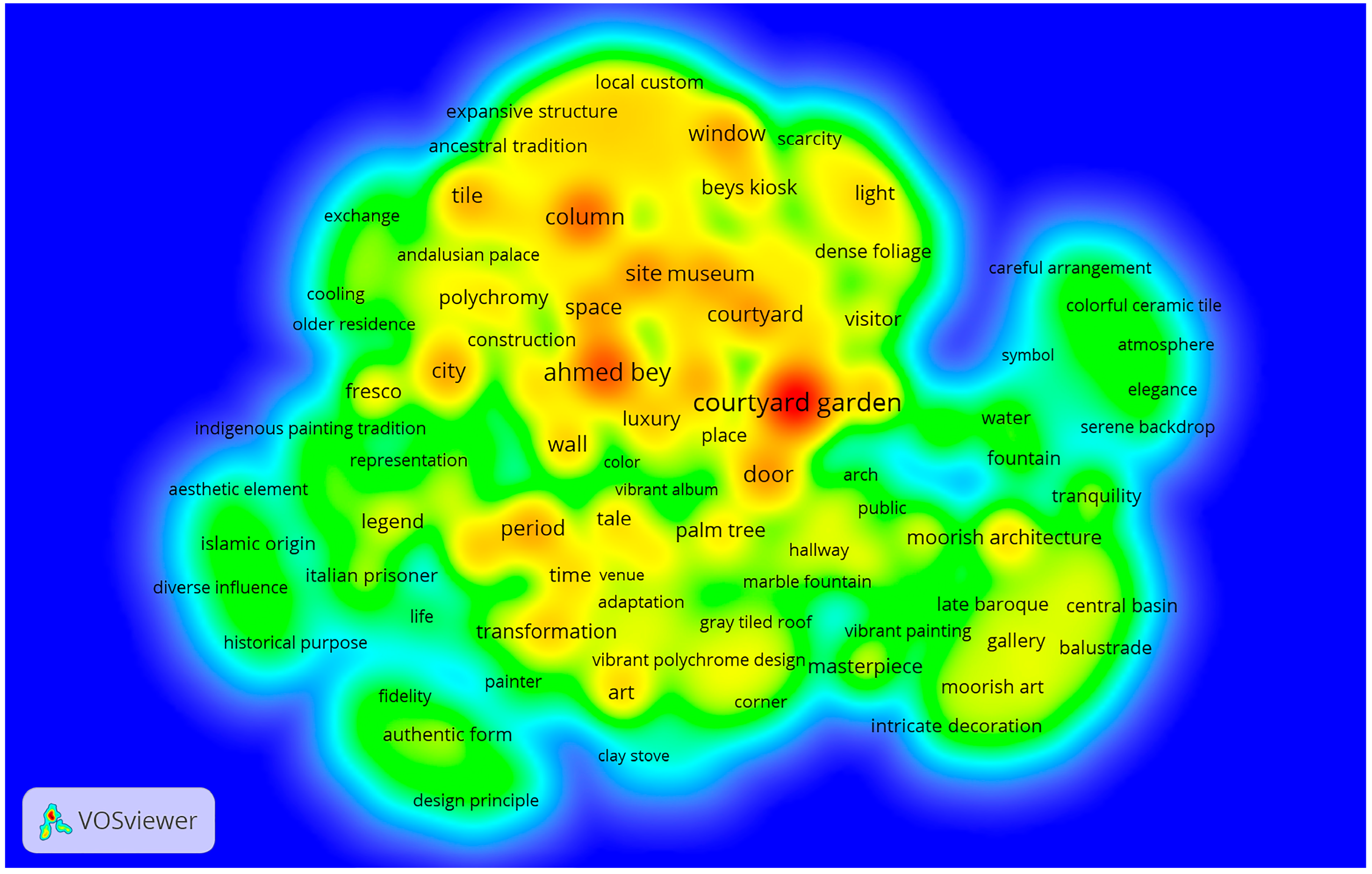






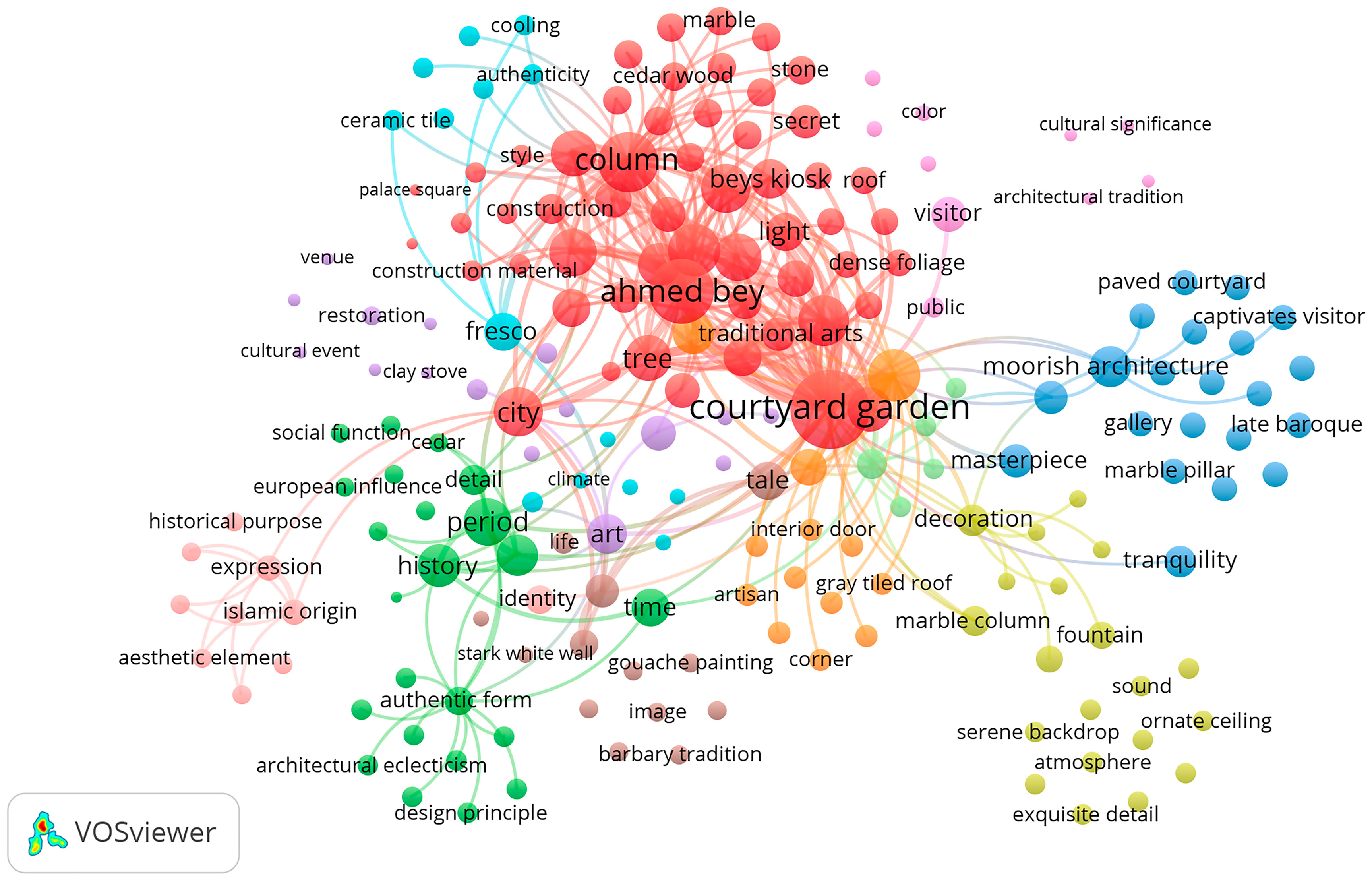
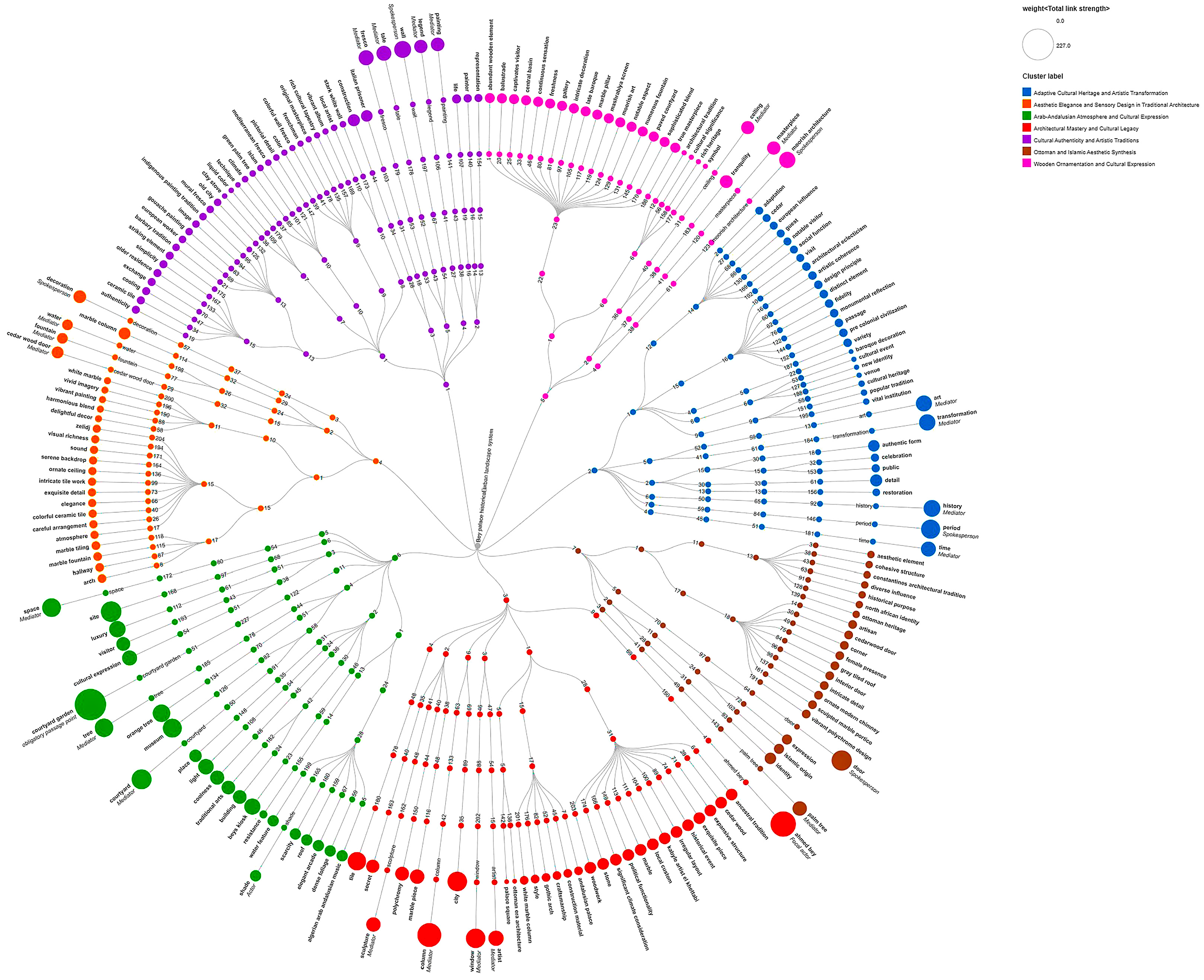
| A. ANT translation moments, roles, and related computational tasks | ||
| ANT Moment/Concept | Role of ANT Process/Concept | Related Algorithms and Computational Tasks |
| Problematization | Defines the research problem, identifies contentious issues, candidate actors/actants and the scope of the controversy [7]. | Natural-language processing (NLP): tokenization, TF–IDF weighting, and entity extraction [46]. |
| Interessement | Creates alignments and stabilizes relationships by enrolling allies, framing issues, and negotiating roles [7,8]. | Association-strength normalization and co-occurrence mapping [47]. |
| Enrollment | Organizes and consolidates roles, leading to the formation of cohesive groups or assemblies of actors [7]. | Graph Layout Algorithms using Force-directed algorithms based on the LinLog Layout algorithm [48]. |
| Mobilization | Stage where enrolled actors act collectively to implement decisions, solidify alliances, and produce material changes or coordinated outcomes [14]. | Community detection algorithm based on Louvain Modularity Algorithm [49]. |
| Boundary Objects/Mediators | Act as interfaces that enable translation and coordination across heterogeneous actor groups [50,51]. | Fractional counting [52] and intercluster linkage computation based on computational analysis via co-occurrence analysis algorithm [44]. |
| Spokespersons/Focal actors/Obligatory passage point (OPP) | Actors or entities that represent, speak for [7] or coordinate the interests of a group within the network [8]. | Centrality analysis (eigenvector/betweenness) and total link strength measures [36]. |
| B. Functions of algorithms and related tasks in network analysis tools | ||
| Algorithms and Computational Tasks | Function of Algorithms/Computational Analysis | Related Tasks in Network Analysis Tools (VOSviewer/RAWGraphs) |
| Natural language processing algorithms NLP (TF–IDF) [46]. | Extracts and weighs textual terms representing actors and concepts [47]. | Preprocessing using VOSviewer input (text-mining module) [46]. |
| Association Strength Normalization algorithm [47]. | Computes relational proximity between terms to reveal associative structures [47,53]. | “Association strength normalization” option in VOSviewer [52]. |
| Force-Directed (LinLog) Layout algorithm | Displays network geometry through attraction and repulsion forces [48]. | “LinLog/Force Layout” parameter in VOSviewer or RAWGraphs [53]. |
| Louvain Modularity algorithm | Detects cohesive clusters/communities based on modularity Q [49]. | “Cluster Detection” tool through Modularity normalization in VOSviewer software which report modularity Q and number of clusters [53]. |
| Fractional Counting | Allocates partial co-occurrence weight to each document contributor [52]. | “Counting Method via Fractional” option in VOSviewer [53]. |
| Centrality Measures algorithms (Eigenvector/Betweenness) | Identifies influential/bridging actors controlling information flow [35,54]. | Exploitation of computational analysis results from VOSviewer software and Regression analysis in RAWGraphs tool [55]. |
| Computational analysis via co-occurrence analysis algorithm. | This algorithmic task identifies actors with a high number of joint occurrences with other actors in the network [46]. This indicates their influence on other well-connected actors within the network. | “Actors Details through co-occurrence analysis” field in VOSviewer and graph visualization in RAWGraphs tool [55]. |
| C. Algorithm mathematical formulas and mechanism descriptions | ||
| Related Algorithms and Computational Tasks | Mathematical Formula | Description of Mechanism |
| Term Extraction/TF–IDF (NLP) | According to Erkan [56]. | Calculates how important a term/item i is in document j within the corpus N, weighting frequency by inverse document frequency to identify key actors [56]. |
| Association Strength Normalization | According to van Eck and Waltman [47]. | Normalizes co-occurrence counts by marginal frequencies to measure relative association strength between actors i and j [47]. |
| Force-Directed (LinLog) Layout | according to Noack [57]. | Minimizes energy E to position nodes; attraction ∝ link weight w and repulsion ∝ distance d, forming visual clusters [57]. |
| Louvain Modularity algorithm | According to Blondel et al. [58] | Maximizes modularity Q to partition the network into communities with dense internal links and sparse external links [58]. |
| Fractional Counting algorithm | According to Perianes-Rodriguez et al. [52] | Assigns fractional co-occurrence weight to balance contributions from multiterm documents, reducing bias from prolific items [52]. |
| Eigenvector Centrality algorithm | According to Bihari and Pandia [54] Ax = λx | Computes node influence as proportional to the sum of neighbor influences; high-value nodes connect to other high-value nodes [54]. |
| Co-occurrence analysis algorithm | According to Van Eck and Waltman [46] | Computational tasks based on co-occurrence frequency calculation between all items appearing together, this allows to identify bridging or mediating actors [46]. |
| Total Link Strength (TLS) analysis algorithm. | Aggregates all link weights connected to node i, quantifying its overall connectivity and stability in the network. | |
Disclaimer/Publisher’s Note: The statements, opinions and data contained in all publications are solely those of the individual author(s) and contributor(s) and not of MDPI and/or the editor(s). MDPI and/or the editor(s) disclaim responsibility for any injury to people or property resulting from any ideas, methods, instructions or products referred to in the content. |
© 2025 by the authors. Licensee MDPI, Basel, Switzerland. This article is an open access article distributed under the terms and conditions of the Creative Commons Attribution (CC BY) license (https://creativecommons.org/licenses/by/4.0/).
Share and Cite
Bakour, F.; Chougui, A. An Alternative Approach for Sustainable Management of Historic Urban Landscapes Through ANT via Algorithms: The Case of Bey’s Complex Palace in Constantine, Algeria. Sustainability 2025, 17, 9857. https://doi.org/10.3390/su17219857
Bakour F, Chougui A. An Alternative Approach for Sustainable Management of Historic Urban Landscapes Through ANT via Algorithms: The Case of Bey’s Complex Palace in Constantine, Algeria. Sustainability. 2025; 17(21):9857. https://doi.org/10.3390/su17219857
Chicago/Turabian StyleBakour, Fatah, and Ali Chougui. 2025. "An Alternative Approach for Sustainable Management of Historic Urban Landscapes Through ANT via Algorithms: The Case of Bey’s Complex Palace in Constantine, Algeria" Sustainability 17, no. 21: 9857. https://doi.org/10.3390/su17219857
APA StyleBakour, F., & Chougui, A. (2025). An Alternative Approach for Sustainable Management of Historic Urban Landscapes Through ANT via Algorithms: The Case of Bey’s Complex Palace in Constantine, Algeria. Sustainability, 17(21), 9857. https://doi.org/10.3390/su17219857








